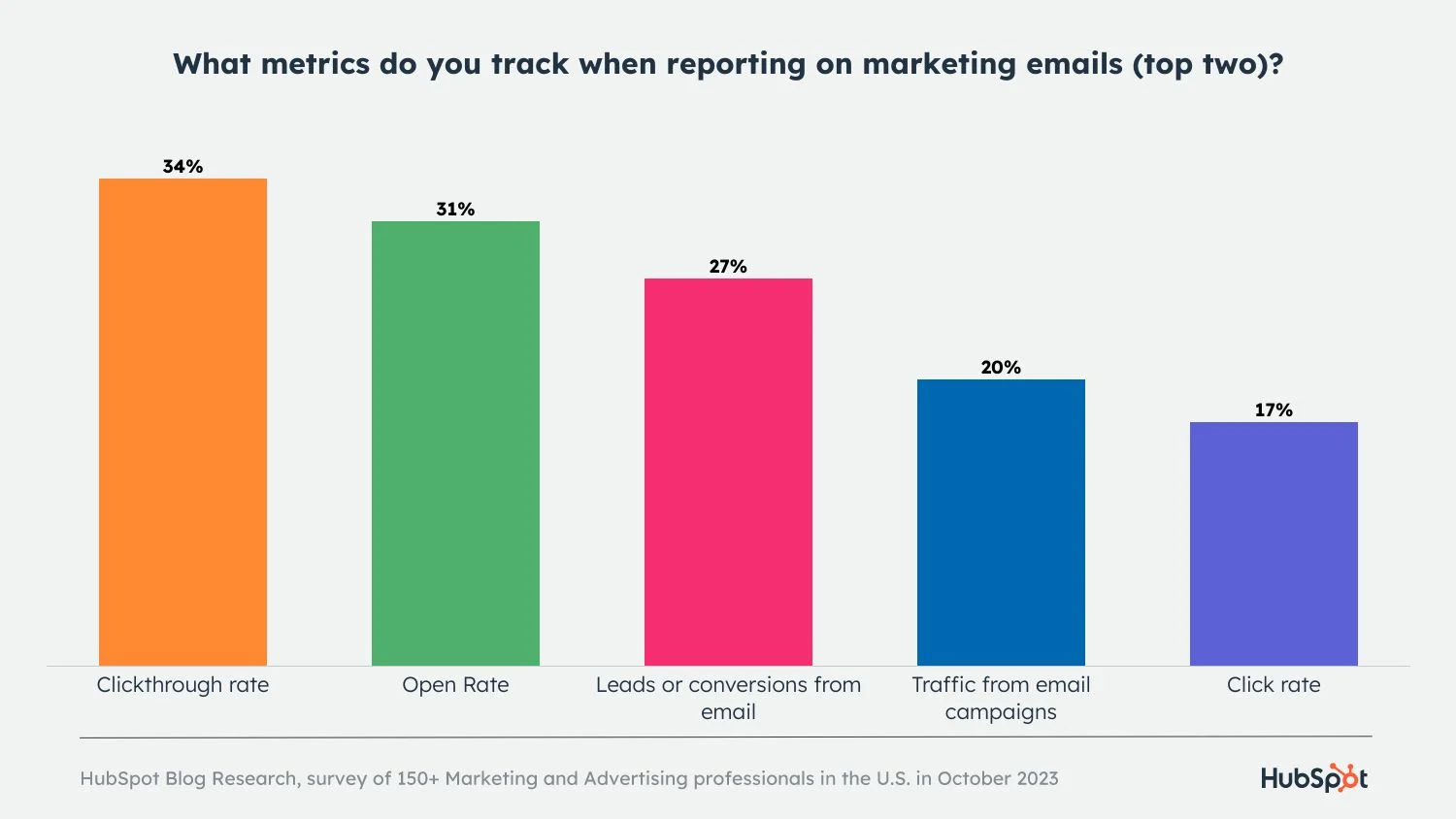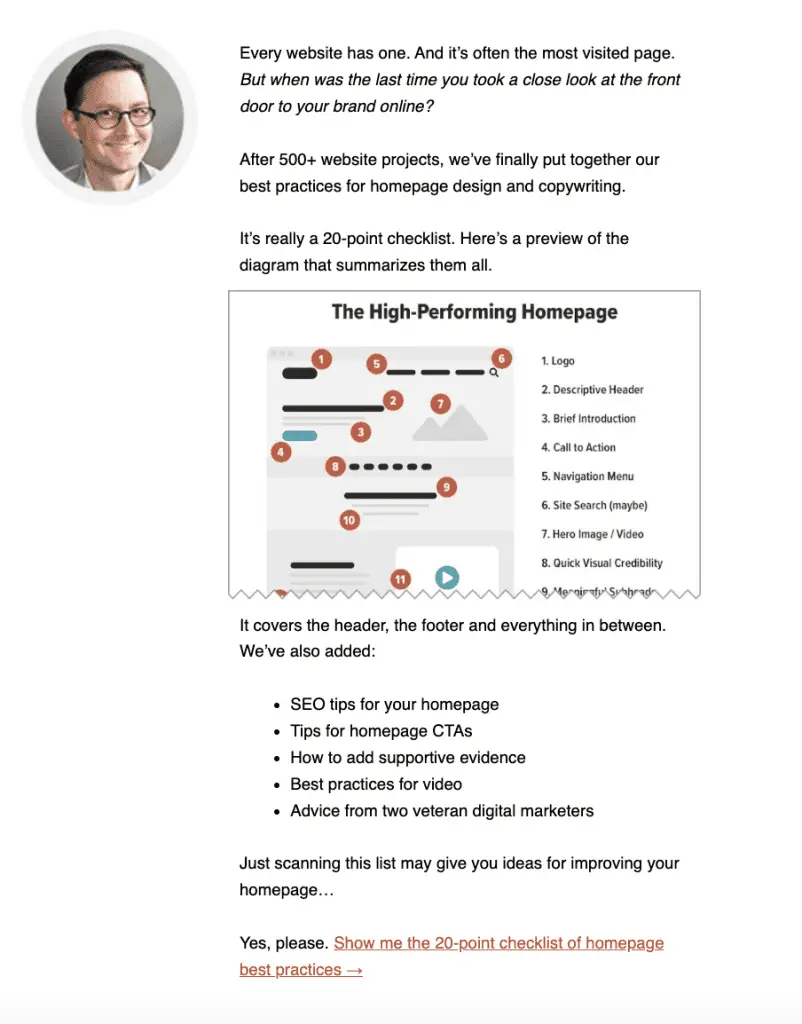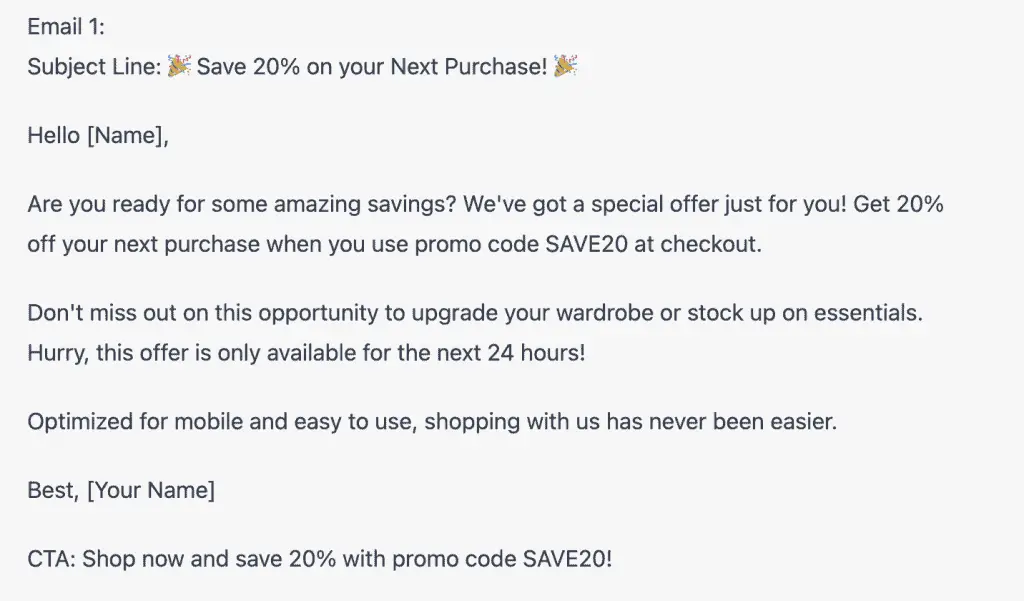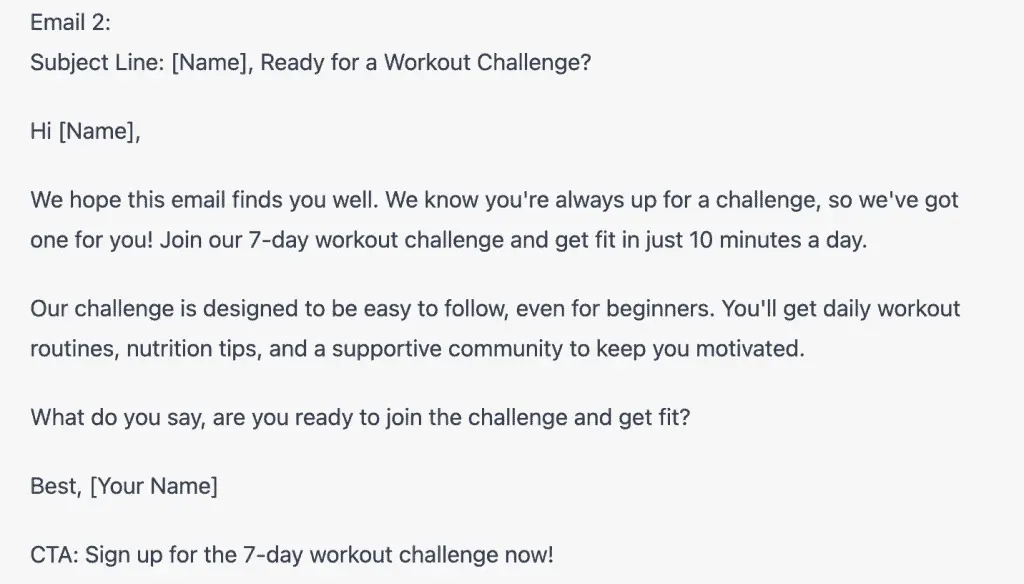In This Article

When you increase email click through rate, you’re going to increase sales. This is no joke. Of course it assumes that where you send prospects after they click matters, but let’s just assume that the links in your emails go to something that converts to a sale.
Email click through rates are the most tracked metric in email marketing.

With the latest privacy technology in place, open rates aren’t a good measure of email success. That’s why it’s more important than ever for you to focus on driving clicks from their emails.
If you want to boost your click-through rate from each of your campaigns, take the time to understand your audience, segment your list, and compose eye-catching subject lines that are optimized for mobile devices. To help you get the most out of each email campaign, here are 10 tips on how to measure click-through rates and examples of emails with successful CTRs.
Understand Your Audience
The first thing every marketing person will ask you is “who is your ideal customer?” or “Who is your audience?” Understanding your audience is essential to any successful email marketing campaign.
Why? Because the emails with the highest click through rates are those that use your ideal customer’s words in them. Understanding your audience will help you to craft a message that speaks directly to them, resonates with them and ultimately entices them to click through.
Here are a few quick tips you can use to uncover the words your customer wants to see:
Go through emails between you and your customer
This is one of my favorite tips. Simply take the time to go through emails that you and your clients and customers exchanged. Specifically look for what words they use to describe their challenges or the features they appreciate most.
Explore Facebook Groups, Forums, Reddits. Quoras, etc.
Another terrific way to get at your customer’s language is to consistently read through relevant or related Facebook groups, forums, Reddit’s, etc. Anywhere your customers are sharing their points of view, problems, challenges, or recommendations.
With the information you’ve collected in these groups, you can segment your list.
When it comes to understanding your target audience, segmentation is key. Segmenting allows you to send more targeted emails that better meet the needs of each individual subscriber. For example, if you have a list of customers who have purchased from you in the past year, you can create a segment for those customers and send them special offers or discounts related to their purchase history. This type of segmentation ensures that each customer receives an email tailored specifically for them which increases engagement with your message.
Crafting engaging subject lines is also important when trying to increase click through rates in emails. Your subject line should be short (no more than 50 characters) yet descriptive enough so readers know what’s inside the email before opening it. You should also use action words like “discover” or “learn” as these tend to entice people into clicking on the link within the email body copy itself.
In addition, optimizing for mobile devices is critical since most people now access their emails via smartphones or tablets rather than desktops or laptops computers . Make sure all images display properly across different screen sizes and keep text concise so it can easily be read without having to scroll down too much on smaller screens . Additionally , include buttons instead of links whenever possible as this makes it easier for users on mobile devices click through quickly .
Finally, make sure every email includes a clear call-to-action (CTA). A CTA tells subscribers exactly what they should do next after reading an email – whether it’s signing up for a webinar, downloading an ebook, or making a purchase. Without one, readers may not take any action at all which defeats the purpose of sending out an email in first place. Examples of effective CTAs include “Sign Up Now”, “Download Here”, and “Shop Now”.
Once you understand your audience, it’s time to segment them into different groups so that you can tailor your emails and maximize click through rates.
Segment Your List
With the information you’ve collected about your customer and the language and words they use, you’re ready to segment your list.
Segmenting your email list is an important part of any successful email marketing campaign. It allows you to target specific audiences with relevant content, increasing the likelihood that they will engage with it and click through to your website or other landing page. By segmenting your list, you can also better track the performance of different campaigns and tailor future emails accordingly.
Basic Demographic Segmentation
When segmenting your list, there are several factors to consider: demographics such as age, gender, location; interests; past purchases; and even how recently someone subscribed to your mailing list. This data can be used to create segments based on common characteristics among subscribers so that each message is tailored specifically for them. For example, if you’re a clothing retailer selling both men’s and women’s items, you could create two separate lists – one for male customers and another for female customers – so that each group receives messages about products they are more likely interested in purchasing.
Engagement Level Segmentation
Another way to segment is by engagement level – those who have opened emails from you before versus those who haven’t yet interacted with any of your messages – so that those who are already engaged receive more frequent communications than those who aren’t as familiar with what you offer yet. You may also want to consider creating segments based on purchase history or loyalty status (e.g., VIP members). Doing this allows you to send special offers or discounts only available for certain groups of people which helps encourage further engagement from them while simultaneously rewarding their loyalty towards your brand/business.
Interest or Use Case Segmentation
One of my favorite ways to segment my mailing list is by interest. You can do this by segmenting your list based on the events or downloads your subscribers registered for or signed up to receive. This will not only help you measure and analyze where you should be focusing your efforts, it will help you send emails that they are interested in and will open.
Geographic Segmentation
Finally, don’t forget about geography. If possible try targeting local areas within cities where most of your customers live or work – this gives a personal touch since many people prefer buying from local businesses over big chains when given the option. Additionally it’s worth considering time zones too since sending out emails at times when recipients are most likely awake increases chances of success significantly.
Overall, segmentation is key when it comes to improving click-through rates because it ensures that everyone receiving an email has something in common which makes them more likely to respond positively towards the message being sent out.
Segmenting your list allows you to send more targeted emails, which can help increase click-through rates. Now let’s look at how crafting engaging subject lines can further boost those rates.
Craft Engaging Subject Lines
Subject lines are the first thing readers see when they receive an email, so it’s important to craft subject lines that will entice them to open and click through. Here are some tips for creating engaging subject lines:
1. Keep It Short & Sweet:
Subject lines should be no more than 50 characters long, as longer subject lines can get cut off in mobile inboxes. Use simple language and avoid jargon or complicated words to make sure your message is clear and concise.
2. Include Numbers & Emojis:
Including numbers in your subject line (e.g., “5 Tips To Increase Your Click Through Rate”) can help draw attention to your email while emojis can add a fun touch that makes it stand out from other emails in the inbox.
3. Personalize It:
Addressing recipients by name or mentioning their interests/needs can help increase engagement with your emails as people feel like you’re speaking directly to them rather than sending a generic message out into the ether of cyberspace.
4. Ask Questions:
Asking questions in your subject line encourages readers to find out what the answer is by clicking on the email – this tactic works especially well if you include an element of curiosity (e.g., “What Are The Secrets To Crafting Engaging Subject Lines?”).
Make it timely and relevant:
If there is something timely happening, such as a holiday or special event, use this opportunity to create a relevant and eye-catching subject line (e.g., “Happy Thanksgiving From [Your Company]”). This helps show customers that you are up-to-date on current events and gives them another reason why they should open your email.
Crafting engaging subject lines is essential for increasing email click through rates. To take your email marketing to the next level, it’s important to optimize for mobile devices as well.
Optimize for Mobile Devices
Mobile devices are becoming increasingly popular and more people are using them to access the internet. This means that businesses need to optimize their emails for mobile devices in order to reach as many potential customers as possible. Optimizing emails for mobile devices can help increase click through rates, which is essential for any successful marketing campaign.
Consider the size of the screen
When optimizing an email for a mobile device, it’s important to consider the size of the screen and how much content can be displayed at once. Emails should be designed with a single column layout so they display correctly on all types of screens, from small phones up to large tablets. It’s also important to keep text short and concise since most people won’t want to read long blocks of text on their phone or tablet. Additionally, images should be optimized so they don’t take too long to load on slower connections such as 3G or 4G networks.
Check your links
Another key factor when optimizing emails for mobile devices is making sure that links work properly across different platforms and browsers. Links should open in new windows if necessary and buttons should be big enough so users can easily tap them with their fingers without having to zoom in first. Finally, it’s important that emails look good regardless of whether they’re being viewed on a desktop computer or a smartphone – this will ensure maximum engagement from readers no matter what type of device they’re using.
Make it Personal
Including personalization elements such as names or location-based information can also help increase click through rates when sending out emails via mobile devices since these elements make messages feel more relevant and targeted towards each individual reader’s needs or interests . For example, adding someone’s name into the subject line increases open rates by 22%. Similarly, including location-specific details like city names has been shown to boost click through rates by 10%.
Don’t forget to test
Testing is an essential part of optimizing emails for mobile devices, as there are many variables involved such as screen sizes, connection speeds, and operating systems. A/B testing allows marketers to see which versions perform better than others before launching campaigns out into the wild. By taking advantage of these tools, businesses can maximize their chances of success when sending out email campaigns via mobile devices.
To make the most of your email marketing efforts, give mobile optimization a try! It’s an easy way to ensure that everyone who views your emails can easily take in all its information. Plus, it looks great on any device – so you’ll be sure to get people clicking through and taking action every time.
Include a Clear Call-to-Action
A clear call-to-action (CTA) is an essential element of any email marketing campaign. It’s the part of your message that tells the reader what to do next. Without a CTA, you won’t be able to drive conversions or measure success.
When crafting your CTA, it’s important to make sure it stands out from the rest of your content and encourages readers to take action. Make sure it’s visible and easy for readers to find – try using bold text or contrasting colors so that it catches their eye quickly. Additionally, use language that conveys urgency and makes them feel like they need to act now in order to get something valuable out of your offer.
In addition, consider personalizing CTAs by including customer names or other details about them in the copy itself – this can help increase click through rates as customers will feel more connected with you when they see personalized messages tailored just for them. Finally, don’t forget about testing different versions of CTAs on different segments of customers – this way you can determine which ones work best for each group and adjust accordingly based on results.
For example, if you’re running an email campaign promoting a new product launch then include two separate CTAs: one offering discounts exclusively for existing customers and another offering free shipping for first time buyers only. This allows both groups to benefit from the promotion while also giving incentive for people who may not have purchased before but are interested in trying out what you have available now.
It’s also important not to overwhelm readers with too many choices when creating calls-to-action; keep things simple by providing no more than three options at once so that they don’t become overwhelmed or confused by too much information all at once. For instance, if you’re sending out an email newsletter featuring several articles then provide links directly below each article rather than listing all possible destinations at once near the top/bottom of the page – this helps ensure readers stay focused on taking action instead getting distracted by multiple possibilities presented simultaneously.
Overall, including a clear call-to-action in emails is key if you want people reading them to take action after doing so. This could be signing up for a service/product trial period or simply clicking through website links provided within the message itself. By following these tips outlined above (and others), businesses should be able to create effective campaigns that drive conversions without overwhelming potential customers with too much information all at once.
Having a clear call-to-action in your emails is essential to driving higher click through rates. Now let’s look at examples of emails that have achieved high click through rates.
Examples of Emails with High Click Through Rates
Finally, let’s take a look at some examples of highly converting emails.
No example section would be complete without an email from one of my favorite content marketers, Andy Crestodina from Orbit Media.

He’s one of the most requested speakers in the world of Content Marketing and when you read this email, you’ll see why.
It’s the ideal content marketers email; it’s a mini blog post, it has a little graphic, it’s got teasers, it’s friendly, it’s readable, and it’s just plain yummy.
Here’s a high-click rate email for a product or specific offer you can try:

If you’re more of a coach or consultant, challenge emails do really well

These are really generic, but you can easily make them your own.
FAQs in Relation to Increase Email Click Through Rate
What causes low click-through rate email?
Low click-through rate emails can be caused by a variety of factors. Poor subject lines, lack of personalization, and sending too many emails are some of the most common causes. Emails that don’t offer any value to the recipient or have unclear call-to-actions can also lead to low click-through rates. Additionally, if your email content is not optimized for mobile devices it may cause users to abandon the message before they even open it. Finally, sending emails at times when people are less likely to check their inboxes can also contribute to low click-through rates.
What is a good click-through rate for email?
The average click-through rate for email campaigns is between 2-5%. However, this can vary greatly depending on the type of content and audience. For example, emails with a more personal touch or those that offer discounts tend to have higher click-through rates than generic newsletters. Additionally, different industries may experience varying levels of success when it comes to email marketing campaigns. Ultimately, the best way to determine what your business’s ideal click-through rate should be is by testing different approaches and tracking results over time.
What is a good email click-through rate 2023?
The average email click-through rate for 2023 is expected to be around 2.5%. This means that, on average, out of every 100 emails sent, 2.5 people will click through and visit the website or landing page linked in the email. However, this number can vary greatly depending on factors such as industry, content quality and personalization level. To maximize your click-through rate in 2023 it’s important to focus on creating relevant content tailored to your audience and optimizing each element of your email campaigns from subject lines to visuals.
Is 7% click-through rate good?
It depends on the context. Generally speaking, a 7% click-through rate is considered to be average for most marketing campaigns. However, it can vary depending on the industry and type of campaign. For example, email campaigns tend to have higher click-through rates than social media ads. Additionally, certain industries may have higher or lower benchmarks that are considered good or bad performance indicators. Ultimately, it’s important to compare your own results against industry averages in order to determine whether a 7% click-through rate is good for your particular business and
Conclusion
By understanding your audience, segmenting your list, crafting engaging subject lines, optimizing for mobile devices and including a clear call-to-action in your emails you can increase email click through rate. Examples of emails with high click through rates are also helpful to understand what works best for different audiences. With these tips and strategies you can create effective email campaigns that will help boost engagement and generate more leads.